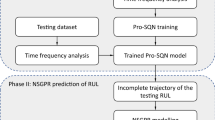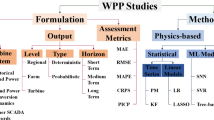Abstract
Recently, there has been a global shift toward clean energy sources, and wind turbines (WT) play a crucial role as one of the most popular renewable generation sources. Despite their significant potential, WTs incur high operation and maintenance (O &M) costs due to the challenging operational conditions they face, such as pollution and atmospheric discharges. These stresses reduce the life expectancy of such equipment by increasing the occurrence of failures, thereby diminishing wind farm reliability. To mitigate these failure events, the prediction of the remaining useful life (RUL) of WTs is essential. This prediction, specifically direct RUL prediction, is often made by data-driven methods. However, to achieve competitive levels of accuracy, data-driven methods found in the literature often rely on extensive datasets or high-complexity deep learning models, because historical data containing failures in WTs are scarce, which presents challenges in practical implementation. This paper introduces a novel methodology for rotor RUL prediction in WTs. This method achieved an accuracy of over \(80\%\) using simple machine learning algorithms trained with limited data, making it easy to implement and cost-effective. It is expected that this methodology will assist energy companies in optimizing their operation and maintenance planning processes and contribute to the national energy sector’s progress toward achieving global sustainable goals.










Similar content being viewed by others
References
Alfarizi, M. G., Tajiani, B., Vatn, J., & Yin, S. (2023). Optimized random forest model for remaining useful life prediction of experimental bearings. IEEE Transactions on Industrial Informatics, 19(6), 7771–7779. https://doi.org/10.1109/TII.2022.3206339
Associação Brasileira de Normas Técnicas. (1994). Nbr 5462—confiabilidade e mantenabilidade. Technical report, Associação Brasileira de Normas Técnicas, Rio de Janeiro RJ, novembro.
Barandas, M., Folgado, D., Fernandes, L., Santos, S., Abreu, M., Bota, P., Liu, H., Schultz, T., & Gamboa, H. (2020). TSFEL: Time series feature extraction library. SoftwareX, 11, 100456. https://doi.org/10.1016/j.softx.2020.100456
Carroll, J., Koukoura, S., McDonald, A., Charalambous, A., Weiss, S., & McArthur, S. (2019). Wind turbine gearbox failure and remaining useful life prediction using machine learning techniques. Wind Energy, 22(3), 360–375. https://doi.org/10.1002/we.2290
Chan, D., & Mo, J. (2017). Life cycle reliability and maintenance analyses of wind turbines. Energy Procedia, 110, 328–333. https://doi.org/10.1016/j.egypro.2017.03.148
Franco, I. T., & de Figueiredo, R. M. (2023). Predictive maintenance: An embedded system approach. Journal of Control, Automation and Electrical Systems, 34(1), 60–72. https://doi.org/10.1007/s40313-022-00949-4
Hall, M. A. (1999). Correlation-based feature selection for machine learning. Ph.D. thesis, The University of Waikato.
Hu, Y., Li, H., Shi, P., Chai, Z., Wang, K., Xie, X., & Chen, Z. (2018). A prediction method for the real-time remaining useful life of wind turbine bearings based on the wiener process. Renewable Energy, 127, 452–460. https://doi.org/10.1016/j.renene.2018.04.033
International Electrotechnical Commission. (2019). Slovenski Standard Sist iec 60050-192:2019—International electrotechnical vocabulary—part 192: Dependability. Technical report.
IRENA. (2022). Renewable energy technologies. https://www.irena.org/Statistics/View-Data-by-Topic/Capacity-and-Generation/Technologies.
Jin, X., Chen, Y., Wang, L., Han, H., & Chen, P. (2021). Failure prediction, monitoring and diagnosis methods for slewing bearings of large-scale wind turbine: A review. Measurement, 172, 108855. https://doi.org/10.1016/j.measurement.2020.108855
Katipamula, S., & Brambley, M. R. (2005). Review article: Methods for fault detection, diagnostics, and prognostics for building systems-a review, part i. HVAC &R Research, 11(1), 3–25. https://doi.org/10.1080/10789669.2005.10391123.
Li, Z., Zhang, X., Kari, T., & Hu, W. (2021). Health assessment and remaining useful life prediction of wind turbine high-speed shaft bearings. Energies, 14(15), 4612. https://doi.org/10.3390/en14154612
Liu, W., Tang, B., Han, J., Lu, X., Hu, N., & He, Z. (2015). The structure healthy condition monitoring and fault diagnosis methods in wind turbines: A review. Renewable and Sustainable Energy Reviews, 44, 466–472. https://doi.org/10.1016/j.rser.2014.12.005
Liu, Y., Hu, X., & Zhang, W. (2019). Remaining useful life prediction based on health index similarity. Reliability Engineering & System Safety, 185, 502–510. https://doi.org/10.1016/j.ress.2019.02.002
Mathew, V., Toby, T., Singh, V., Rao, B. M., & Kumar, M. G. (2017). Prediction of remaining useful lifetime (RUL) of turbofan engine using machine learning. In 2017 IEEE international conference on circuits and systems (ICCS) (pp. 306–311). https://doi.org/10.1109/ICCS1.2017.8326010.
ONS. (2023). Sobre o SIN—O Sistema em Números. https://www.ons.org.br/paginas/sobre-o-sin/o-sistema-em-numeros.
Ozturk, S. (2019). Forecasting wind turbine failures and associated costs: Investigating failure causes, effects and criticalities, modeling reliability and predicting time-to-failure, time-to-repair and cost of failures for wind turbines using reliability methods and machine learning techniques. Columbia University.
Rausand, M., & Øien, K. (1996). The basic concepts of failure analysis. Reliability Engineering & System Safety, 53(1), 73–83. https://doi.org/10.1016/0951-8320(96)00010-5
Rezamand, M., Kordestani, M., Carriveau, R., Ting, D.S.-K., & Saif, M. (2020). An integrated feature-based failure prognosis method for wind turbine bearings. IEEE/ASME Transactions on Mechatronics, 25(3), 1468–1478. https://doi.org/10.1109/TMECH.2020.2978136
Santelo, T. N., de Oliveira, C. M. R., Maciel, C. D., & Monteiro, J. R. B. de A. (2022). Wind turbine failures review and trends. Journal of Control, Automation and Electrical Systems, 33(2), 505–521. https://doi.org/10.1007/s40313-021-00789-8
Scikit-learn. (2023a). Sklearn feature selection—selectkbest. https://scikit-learn.org/stable/modules/generated/sklearn.feature_selection.SelectKBest.html.
Scikit-learn. (2023b) Sklearn feature selection—sequentialfeatureselector. https://scikit-learn.org/stable/modules/generated/sklearn.feature_selection.SequentialFeatureSelector.html.
Tang, M., Kuang, Z., Zhao, Q., Wu, H., & Yang, X. (2020). Fault detection of wind turbine pitch system based on multiclass optimal margin distribution machine. Mathematical Problems in Engineering, 2020, 2091382. https://doi.org/10.1155/2020/2091382
Tautz-Weinert, J., & Watson, S. J. (2017). Using scada data for wind turbine condition monitoring–A review. IET Renewable Power Generation, 11(4), 382–394. https://doi.org/10.1049/iet-rpg.2016.0248
Turnbull, A., Carroll, J., Koukoura, S., & McDonald, A. (2019). Prediction of wind turbine generator bearing failure through analysis of high-frequency vibration data and the application of support vector machine algorithms. The Journal of Engineering, 2019(18), 4965–4969. https://doi.org/10.1049/joe.2018.9281
Wang, S., Huang, Y., Li, L., Liu, C., & Zhang, D. (2017). Dynamic analysis of wind turbines including nacelle-tower-foundation interaction for condition of incomplete structural parameters. Advances in Mechanical Engineering. https://doi.org/10.1177/1687814017692940
Wang, Y., Zhao, Y., & Addepalli, S. (2020). Remaining useful life prediction using deep learning approaches: A review. Procedia Manufacturing, 49, 81–88. https://doi.org/10.1016/j.promfg.2020.06.015
Wei, L., Qian, Z., & Zareipour, H. (2020). Wind turbine pitch system condition monitoring and fault detection based on optimized relevance vector machine regression. IEEE Transactions on Sustainable Energy, 11(4), 2326–2336. https://doi.org/10.1109/TSTE.2019.2954834
Williams, L., Phillips, C., Sheng, S., Dobos, A., & Wei, X. (2020). Scalable wind turbine generator bearing fault prediction using machine learning: A case study. In 2020 IEEE international conference on prognostics and health management (ICPHM) (pp. 1–9). https://doi.org/10.1109/ICPHM49022.2020.9187050.
Xiao, C., Liu, Z., Zhang, T., & Zhang, L. (2019). On fault prediction for wind turbine pitch system using radar chart and support vector machine approach. Energies. https://doi.org/10.3390/en12142693
Zhao, Y., Li, D., Dong, A., Kang, D., Lv, Q., & Shang, L. (2017). Fault prediction and diagnosis of wind turbine generators using scada data. Energies, 10(8), 1210. https://doi.org/10.3390/en10081210
Acknowledgements
The work is being developed within the scope of the ANEEL \( R \& D\) Project 0119, titled ‘Intelligent System for Optimized Management of Wind Turbines and Hydro Generators’.
Author information
Authors and Affiliations
Corresponding author
Additional information
Publisher's Note
Springer Nature remains neutral with regard to jurisdictional claims in published maps and institutional affiliations.
Rights and permissions
Springer Nature or its licensor (e.g. a society or other partner) holds exclusive rights to this article under a publishing agreement with the author(s) or other rightsholder(s); author self-archiving of the accepted manuscript version of this article is solely governed by the terms of such publishing agreement and applicable law.
About this article
Cite this article
de Souza Pereira Gomes, G., Moreira de Andrade Lopes, S., Carrijo Polonio Araujo, D. et al. Wind Turbine Remaining Useful Life Prediction Using Small Dataset and Machine Learning Techniques. J Control Autom Electr Syst 35, 337–345 (2024). https://doi.org/10.1007/s40313-024-01076-y
Received:
Revised:
Accepted:
Published:
Issue Date:
DOI: https://doi.org/10.1007/s40313-024-01076-y




